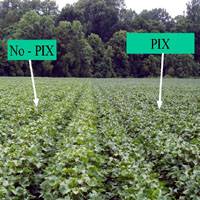PIX Use
 Mepaquat chloride is available on the market in several products (for example, PIX-BASF, Mepex-Griffin, Mepachlor-Microflo, Top-It, from Gowan).
Mepaquat chloride is available on the market in several products (for example, PIX-BASF, Mepex-Griffin, Mepachlor-Microflo, Top-It, from Gowan).
Moisture supply and heat generally result in vigorous growing conditions early season. Plant height may easily exceed 30 inches at early bloom in some fields. Herbicide injury and drainage problems may impact this in many fields most years. Regardless, it is important to monitor and manage plant growth. Growers need adequate vegetative growth to support the soon-to-develop boll load, but if the plant is allowed to run away, it can impact management, especially fruit retention.
History of vigorous early season growth and current crop condition may be the major factors in helping select the proper program, or if PIX is needed at all. Several components of a crop monitoring program can help make PIX decisions. One of these is looking at plant vigor measured as internode lengths (height: node ratio [ HNR]). A lot of information still needs to be gathered to fine-tune this system, but it does have tremendous potential. HNR will vary, but should be in the 1.5 to 1.8 range during mid to late square. If the HNR exceeds 1.8, perhaps PIX is in order if growing conditions are good. If HNR is above 2.0 at first bloom, it is an indication the plant has tremendous "vegetative horsepower" and plant growth, and fruit set must be closely monitored and managed.
Another measurement is called Top-5 Length: Node Ratio (LNR-T5). This measurement, along with fruit set and Nodes Above White Flower (NAWF) can be a tremendous tool in plant management. It is simple and can be measured quickly, thus increasing the likelihood it will be done. The top five internodes represent the area of the plant where the vegetative expansion is occurring. To take this measurement, count the uppermost unfurled main-stem leaf as 0 (zero) and count downward, 1-2-3-4-5. Measure and divide the length by 5. The LNR-T5 is often similar to the HNR, but is not effected by earlier growth. It is an accurate refection of current growth. At early bloom, LNR-T5, possibly, should be in the 1.5 to 1.8 range. If greater than 1.8, the potential for rapid vegetative growth exists. Monitor NAWF and fruit set and make PIX decisions accordingly. As the NAWF progressively gets smaller, say 6 or 5, the LNR-T5 should also be getting shorter if the plant has an average boll load of say 60 percent retention of first position sites. As fruit retention goes down, the plant will want to grow more vegetatively, and as the LNR-T5 increases, the likelihood of a positive response to PIX also increases. If first position boll retention is around 55 to 60 percent and the LNR-T5 is less than 1.5, take a long look at such things as previous PIX used, NAWF, and soil moisture and then make a decision. These measurements are tools and can be a tremendous help when properly measured and applied.
Please monitor your fields, especially fruit retention, Nodes Above White Flower (NAWF) and Height Node Ratio or Length Node Ratio of the Top 5 (LNR-T5). Monitor before you make plant growth regulator decisions. If you will keep track of development, you can make a more informed decision.
Under conditions of good moisture and warm temperatures, cotton will want to produce vegetative growth. If PIX is applied, be sure to use a high enough rate to do the job.
Publications
News
STARKVILLE, Miss. -- Row crop producers who reported financial loss in 2024 may be eligible for economic assistance through a U.S. Department of Agriculture resource.
STARKVILLE, Miss. -- Row crop growers in Mississippi expect to plant more corn in 2025 than they did last year, but not as much cotton or as many soybeans.
STARKVILLE, Miss.



